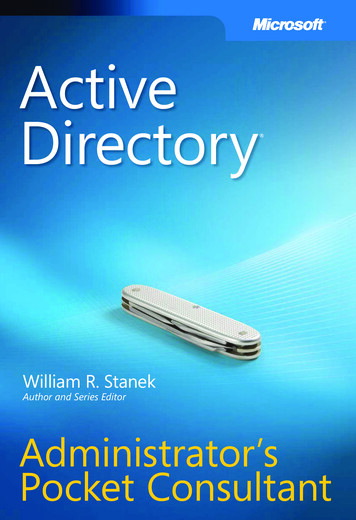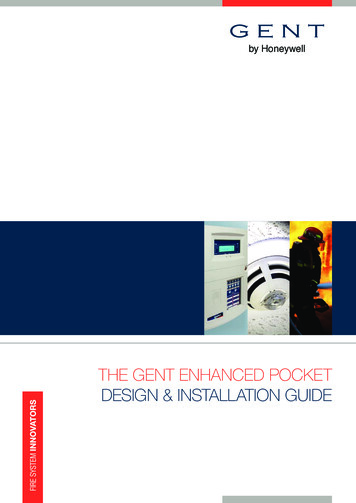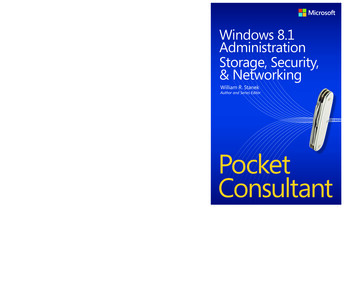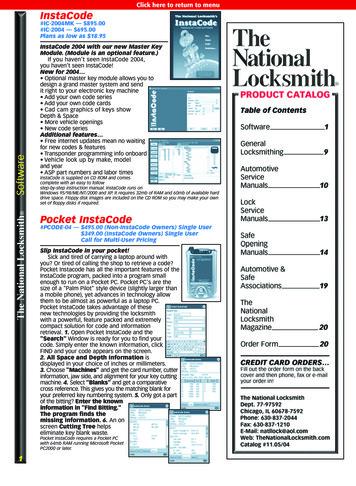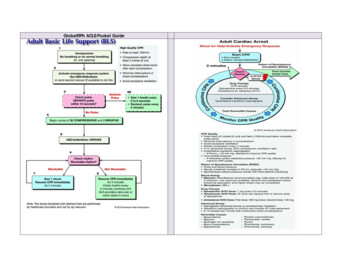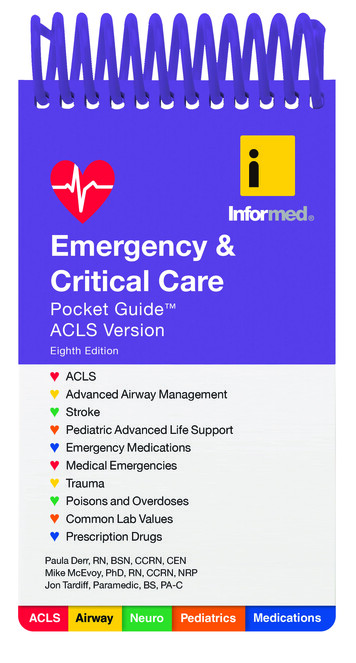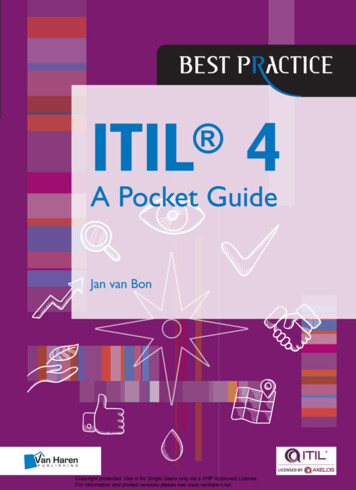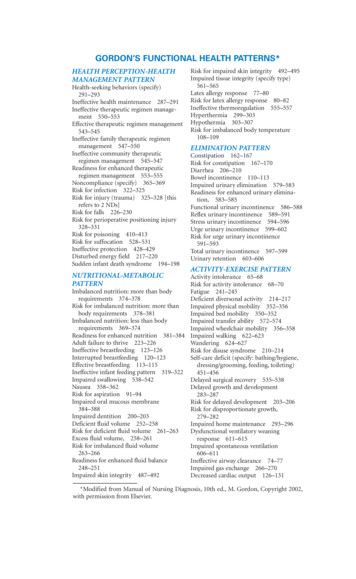
Transcription
00Doenges pocket(F)-FMR2/7/061:52 PMPage iGORDON’S FUNCTIONAL HEALTH PATTERNS*HEALTH PERCEPTION-HEALTHMANAGEMENT PATTERNHealth-seeking behaviors (specify)291–293Ineffective health maintenance 287–291Ineffective therapeutic regimen management 550–553Effective therapeutic regimen management543–545Ineffective family therapeutic regimenmanagement 547–550Ineffective community therapeuticregimen management 545–547Readiness for enhanced therapeuticregimen management 553–555Noncompliance (specify) 365–369Risk for infection 322–325Risk for injury (trauma) 325–328 [thisrefers to 2 NDs]Risk for falls 226–230Risk for perioperative positioning injury328–331Risk for poisoning 410–413Risk for suffocation 528–531Ineffective protection 428–429Disturbed energy field 217–220Sudden infant death syndrome 194–198NUTRITIONAL-METABOLICPATTERNRisk for impaired skin integrity 492–495Impaired tissue integrity (specify type)561–565Latex allergy response 77–80Risk for latex allergy response 80–82Ineffective thermoregulation 555–557Hyperthermia 299–303Hypothermia 303–307Risk for imbalanced body temperature108–109ELIMINATION PATTERNConstipation 162–167Risk for constipation 167–170Diarrhea 206–210Bowel incontinence 110–113Impaired urinary elimination 579–583Readiness for enhanced urinary elimination, 583–585Functional urinary incontinence 586–588Reflex urinary incontinence 589–591Stress urinary incontinence 594–596Urge urinary incontinence 599–602Risk for urge urinary incontinence591–593Total urinary incontinence 597–599Urinary retention 603–606ACTIVITY-EXERCISE PATTERNActivity intolerance 65–68Risk for activity intolerance 68–70Imbalanced nutrition: more than bodyFatigue 241–245requirements 374–378Deficient diversonal activity 214–217Risk for imbalanced nutrition: more thanImpaired physical mobility 352–356body requirements 378–381Impaired bed mobility 350–352Imbalanced nutrition: less than bodyImpaired transfer ability 572–574requirements 369–374Impaired wheelchair mobility 356–358Readiness for enhanced nutrition 381–384 Impaired walking 622–623Adult failure to thrive 223–226Wandering 624–627Ineffective breastfeeding 123–126Risk for disuse syndrome 210–214Interrupted breastfeeding 120–123Self-care deficit (specify: bathing/hygiene,Effective breastfeeding 113–115dressing/grooming, feeding, toileting)Ineffective infant feeding pattern 319–322451–456Impaired swallowing 538–542Delayed surgical recovery 535–538Nausea 358–362Delayed growth and developmentRisk for aspiration 91–94283–287Impaired oral mucous membraneRisk for delayed development 203–206384–388Risk for disproportionate growth,Impaired dentition 200–203279–282Deficient fluid volume 252–258Impaired home maintenance 293–296Risk for deficient fluid volume 261–263Dysfunctional ventilatory weaningExcess fluid volume, 258–261response 611–615Risk for imbalanced fluid volumeImpaired spontaneous ventilation263–266606–611Readiness for enhanced fluid balanceIneffective airway clearance 74–77248–251Impaired gas exchange 266–270Impaired skin integrity 487–492Decreased cardiac output 126–131*Modified from Manual of Nursing Diagnosis, 10th ed., M. Gordon, Copyright 2002,with permission from Elsevier.
00Doenges pocket(F)-FMR2/7/06Ineffective tissue perfusion (specify)565–572Autonomic dysreflexia 97–100Risk for autonomic dysreflexia 100–103Disorganized infant behavior 310–316Risk for disorganized infant behavior318–319Readiness for enhanced organized infantbehavior 316–318Risk for peripheral neurovascular dysfunction 407–410Decreased intracranial adaptive capacity331–334Sedentary lifestyle 342–346SLEEP-REST PATTERNDisturbed sleep pattern 502–507Sleep deprivation 498–502Readiness for enhanced sleep 495–497COGNITIVE-PERCEPTUALPATTERNAcute pain 388–392Chronic pain 392–396Disturbed sensory perception (specify)475–480Unilateral neglect 362–365Deficient knowledge (specify) 334–338Readiness for enhanced knowledge(specify) 338–340Disturbed thought processes 557–561Acute confusion 156–159Chronic confusion 159–161Impaired environmental interpretationsyndrome 220–223Impaired memory 347–349Decisional conflict (specify) 149–152SELF-PERCEPTION-SELFCONCEPT PATTERNFear 245–248Anxiety 82–88Death anxiety 88–91Risk for loneliness 344–347Hopelessness 296–299Powerlessness 421–425Risk for powerlessness 425–428Readiness for enhanced self-concept456–459Situational low self-esteem 463–466Risk for situational low self-esteem466–468Chronic low self-esteem 459–463Body image disturbed 103–107Disturbed personal identity 307–310Risk for violence, self-directed 616–621ROLE-RELATIONSHIP PATTERNAnticipatory grieving 270–273Dysfunctional grieving 273–276Risk for dysfunctional grieving 276–2791:52 PMPage iiChronic sorrow 514–516Ineffective role performance 448–451Social isolation 511–514Impaired social interaction 507–511Relocation stress syndrome 443–446Risk for relocation stress syndrome446–447Interrupted family processes 234–237Dysfunctional family processes: alcoholism230–234Readiness for enhanced family processes237–241Impaired parenting 396–401Risk for impaired parenting 405–406Readiness for enhanced parenting401–404Parental role conflict 153–155Risk for impaired parent/infant/childattachment 94–97Caregiver role strain 132–137Risk for caregiver role strain 137–140Impaired verbal communication 141–145Readiness for enhanced communication145–149Risk for other-directed violence 615–616SEXUALITY-REPRODUCTIVEIneffective sexuality pattern 484–487Sexual dysfunction 480–484Rape-trauma syndrome 429–435COPING-STRESS TOLERANCEPATTERNIneffective coping 180–184Readiness for enhanced coping 186–189Defensive coping 173–176Compromised family coping 170–173Disabled family coping 176–179Readiness for enhanced family coping192–194Ineffective community coping 184–186Readiness for enhanced community coping189–192Ineffective denial 198–200Impaired adjustment 70–74Post-trauma syndrome 413–418Risk for post-trauma syndrome 419–421Risk for suicide 531–535Self-mutilation 468–472Risk for self-mutilation 472–475VALUE-BELIEF PATTERNImpaired religiosity 435–438Risk for impaired religiosity 440–443Readiness for enhanced religiosity438–440Spiritual distress 517–521Risk for spiritual distress 521–524Readiness for enhanced spiritualwell-being, 524–528
00Doenges pocket(F)-FMR2/7/061:52 PMPage iiiNurse’s Pocket GuideDiagnoses, PrioritizedInterventions, and Rationales
00Doenges pocket(F)-FMR2/7/061:52 PMPage vNurse’s Pocket GuideDiagnoses, PrioritizedInterventions, and RationalesEDITION 10Marilynn E. Doenges, APRN, BC–retiredClinical Specialist—Adult Psychiatric/Mental Health NursingAdjunct FacultyBeth-El College of Nursing and Health Sciences, UCCSColorado Springs, ColoradoMary Frances Moorhouse, RN, MSN, CRRN, LNCNurse ConsultantTNT-RN EnterprisesAdjunct FacultyPikes Peak Community CollegeColorado Springs, ColoradoAlice C. Murr, RN, BSN, LNCNurse Consultant/AuthorCollins, MississippiF. A. Davis Company Philadelphia
00Doenges pocket(F)-FMR2/7/061:52 PMPage viF.A. Davis Company1915 Arch StreetPhiladelphia, PA 19103www. fadavis.comCopyright 2006 by F.A. Davis CompanyCopyright 1985, 1988, 1991, 1993, 1996, 1998, 2000, 2002, 2004 byF.A. Davis Company. All rights reserved. This book is protected by copyright. No part of it may be reproduced, stored in a retrieval system, ortransmitted in any form or by any means, electronic, mechanical,photocopying, recording, or otherwise, without written permissionfrom the publisher.Printed in CanadaLast digit indicates print number: 10 9 8 7 6 5 4 3 2 1Publisher: Robert G. Martone, Joanne P. DaCunha, RN, MSNSenior Project Editor: Danielle J. BarskyManager of Art & Design: Carolyn O’BrienAs new scientific information becomes available through basic and clinical research, recommended treatments and drug therapies undergochanges. The author(s) and publisher have done everything possible tomake this book accurate, up to date, and in accord with accepted standards at the time of publication. The authors, editors, and publisher arenot responsible for errors or omissions or for consequences from application of the book, and make no warranty, expressed or implied, inregard to the contents of the book. Any practice described in this bookshould be applied by the reader in accordance with professional standards of care used in regard to the unique circumstances that may applyin each situation. The reader is advised always to check product information (package inserts) for changes and new information regardingdose and contraindications before administering any drug. Caution isespecially urged when using new or infrequently ordered drugs.ISBN-13: 9780-8036-1480-2ISBN-10: 0-8036-1480-2Authorization to photocopy items for internal or personal use, or theinternal or personal use of specific clients, is granted by F.A. DavisCompany for users registered with the Copyright Clearance Center(CCC) Transactional Reporting Service, provided that the fee of .10per copy is paid directly to CCC, 222 Rosewood Drive, Danvers,MA 01923. For those organizations that have been granted a photocopy license by CCC, a separate system of payment has been arranged.The fee code for users of the Transactional Reporting Service is: 80361480/06 0 .10.
00Doenges pocket(F)-FMR2/7/061:52 PMPage ixACKNOWLEDGMENTSA special acknowledgment to Marilynn’s friend, the late DianeCamillone, who provoked an awareness of the role of thepatient and continues to influence our thoughts about theimportance of quality nursing care, and to our late colleague,Mary Jeffries, who introduced us to nursing diagnosis.To our colleagues in NANDA who continue to formulate andrefine nursing diagnoses to provide nursing with the tools toenhance and promote the growth of the profession.Marilynn E. DoengesMary Frances MoorhouseAlice C. Murr
00Doenges pocket(F)-FMR2/7/061:52 PMPage xiContentsHealth Conditions and Client Concerns with Associated NursingDiagnoses appear on pages 628-754.How to Use the Nurse’s Pocket Guide .viiCHAPTER 1The Nursing Process .1CHAPTER 2Application of the Nursing Process .7CHAPTER 3Putting Theory into Practice: Sample Assessment Tools, Planof Care, Mind Mapping, and Documentation .16SECTION 1Assessment Tools for Choosing Nursing Diagnoses .19Adult Medical/Surgical Assessment Tool .20Excerpt from Psychiatric Assessment Tool .30Excerpt from Prenatal Assessment Tool .33Excerpt from Intrapartal Assessment Tool .35SECTION 2Diagnostic Divisions: Nursing Diagnoses OrganizedAccording to a Nursing Focus.37SECTION 3Client Situation and Prototype Plan of Care .43Another Approach to Planning ClientCare—Mind Mapping .58SECTION 4Documentation Techniques: SOAP andFocus Charting .60CHAPTER 4Nursing Diagnoses in Alphabetical Order .65For each nursing diagnosis, the following information is provided:Taxonomy II, Domain, Class, Code, Year Submittedxi
00Doenges pocket(F)-FMR2/7/061:52 PMPage xiiDiagnostic DivisionDefinitionRelated/Risk Factors, Defining Characteristics:Subjective/ObjectiveDesired Outcomes/Evaluation CriteriaActions/InterventionsNursing PrioritiesDocumentation FocusSample Nursing Outcomes & Interventions Classifications(NOC/NIC)CHAPTER 5Health Conditions and Client Concerns with AssociatedNursing Diagnoses .628APPENDIX 1NANDA’s Taxonomy II .755APPENDIX 2Definitions of Taxonomy II Axes .759BIBLIOGRAPHYINDEXxii773CONTENTS762
00Doenges pocket(F)-FMR2/7/061:52 PMPage xiiiHow to Use theNurse’s Pocket GuideThe American Nurses Association (ANA) Social PolicyStatement of 1980 was the first to define nursing as the diagnosis and treatment of human responses to actual and potentialhealth problems. This definition, when combined with the ANAStandards of Practice, has provided impetus and support for theuse of nursing diagnosis. Defining nursing and its effect onclient care supports the growing awareness that nursing care isa key factor in client survival and in the maintenance, rehabilitative, and preventive aspects of healthcare. Changes and newdevelopments in healthcare delivery in the last decade havegiven rise to the need for a common framework of communication to ensure continuity of care for the client moving betweenmultiple healthcare settings and providers. Evaluation anddocumentation of care are important parts of this process.This book is designed to aid the practitioner and studentnurse in identifying interventions commonly associated withspecific nursing diagnoses as proposed by NANDA International (formerly the North American Nursing DiagnosisAssociation). These interventions are the activities needed toimplement and document care provided to the individual clientand can be used in varied settings from acute to community/home care.Chapters 1 and 2 present brief discussions of the nursingprocess, data collection, and care plan construction. Chapter 3contains the Diagnostic Divisions, Assessment Tool, a sampleplan of care, mind map, and corresponding documentation/charting examples. For more in-depth information and inclusive plans of care related to specific medical/psychiatric conditions (with rationale and the application of the diagnoses), thenurse is referred to the larger works, all published by the F.A.Davis Company: Nursing Care Plans Across the Life Span, ed. 7(Doenges, Moorhouse, Geissler-Murr, 2006); Psychiatric CarePlans: Guidelines for Individualizing Care, ed. 3 (Doenges,Townsend, Moorhouse, 1998); and Maternal/Newborn Plans o
GORDON’S FUNCTIONAL HEALTH PATTERNS* HEALTH PERCEPTION-HEALTH MANAGEMENT PATTERN Health-seeking behaviors (specify) 291–293 Ineffective health maintenance 287–291 Ineffective therapeutic regimen manage- ment 550–553 Effective therapeutic regimen management 543–545 Ineffective family therapeutic regimen management 547–550 Ineffective community
